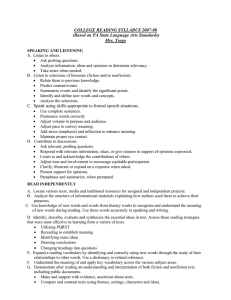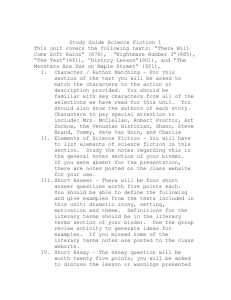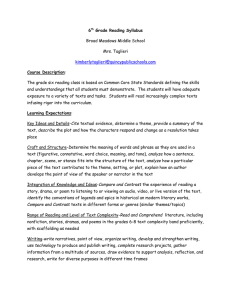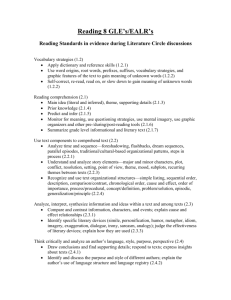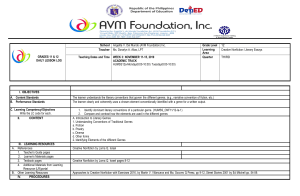READING PROFICIENCY SYLLABUS 2005-2006 (Based on PA State Language Arts Standards)
advertisement
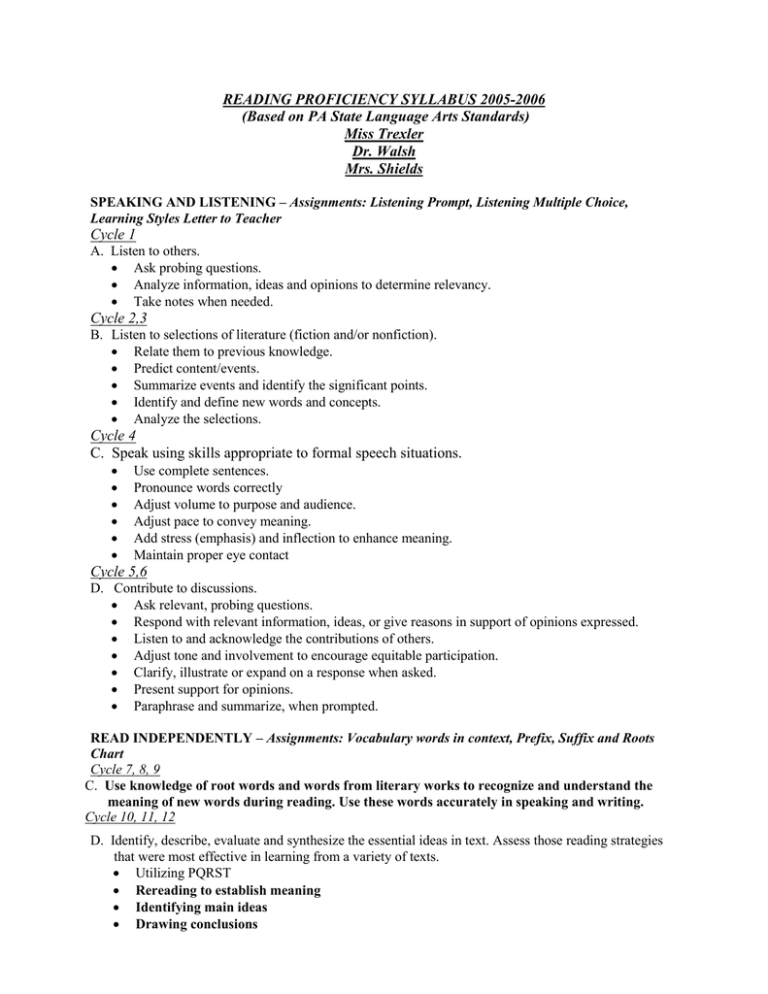
READING PROFICIENCY SYLLABUS 2005-2006 (Based on PA State Language Arts Standards) Miss Trexler Dr. Walsh Mrs. Shields SPEAKING AND LISTENING – Assignments: Listening Prompt, Listening Multiple Choice, Learning Styles Letter to Teacher Cycle 1 A. Listen to others. Ask probing questions. Analyze information, ideas and opinions to determine relevancy. Take notes when needed. Cycle 2,3 B. Listen to selections of literature (fiction and/or nonfiction). Relate them to previous knowledge. Predict content/events. Summarize events and identify the significant points. Identify and define new words and concepts. Analyze the selections. Cycle 4 C. Speak using skills appropriate to formal speech situations. Use complete sentences. Pronounce words correctly Adjust volume to purpose and audience. Adjust pace to convey meaning. Add stress (emphasis) and inflection to enhance meaning. Maintain proper eye contact Cycle 5,6 D. Contribute to discussions. Ask relevant, probing questions. Respond with relevant information, ideas, or give reasons in support of opinions expressed. Listen to and acknowledge the contributions of others. Adjust tone and involvement to encourage equitable participation. Clarify, illustrate or expand on a response when asked. Present support for opinions. Paraphrase and summarize, when prompted. READ INDEPENDENTLY – Assignments: Vocabulary words in context, Prefix, Suffix and Roots Chart Cycle 7, 8, 9 C. Use knowledge of root words and words from literary works to recognize and understand the meaning of new words during reading. Use these words accurately in speaking and writing. Cycle 10, 11, 12 D. Identify, describe, evaluate and synthesize the essential ideas in text. Assess those reading strategies that were most effective in learning from a variety of texts. Utilizing PQRST Rereading to establish meaning Identifying main ideas Drawing conclusions Changing headings into questions Cycle 13, 14 E. Expand a reading vocabulary by identifying and correctly using new words through the study of their relationships to other words. Use a dictionary or related reference. F. Understand the meaning of and apply key vocabulary across the various subject areas. Cycle 15,16,17,18 G. Demonstrate after reading an understanding and interpretation of both fiction and nonfiction text, including public documents. Make and support with evidence, assertions about texts. Compare and contrast texts using themes, settings, characters and ideas. Make extensions to related ideas, topics or information. Assess the validity of the document based on content. Analyze the positions, arguments and evidence in public documents. Evaluate the author’s strategies. Critique public documents to identify strategies common in public discourse. Cycle 19 H. Demonstrate fluency and comprehension in reading. Read familiar materials aloud with accuracy. Self-correct mistakes. Use appropriate rhythm, flow, meter and pronunciation. Read a variety of genres and types of text. Cycle 20, 21,22, 23 READ CRITICALLY IN ALL SUBJECT AREAS A. Read and understand essential content of informational texts and documents in all academic areas Differentiate fact from opinion across a variety of texts by using complete and accurate information, coherent arguments and points of view. Distinguish between essential and nonessential information across a variety of sources, identifying the use of proper references or authorities and propaganda techniques where present. Evaluate text organization and content to determine the author’s purpose and effectiveness according to the author’s theses, accuracy, thoroughness, logic and reasoning. Cycle 24, 25 READ, ANALYZE AND INTERPRET LITERATURE A. Read and understand works of literature B. Analyze the relationships, uses and effectiveness of literary elements used by one or more authors in similar genres including characterization, setting, plot, theme, point of view, tone and style. Cycle 26,27,28 C. Analyze the effectiveness, in terms of literacy quality, of the author’s use of literary terms. Sound Techniques (e.g., rhyme, rhythm, meter, and alliteration). Figurative language (e.g., personification, simile, metaphor, hyperbole, irony, satire). Literary structures (e.g., foreshadowing, flashbacks, progressive and digressive time). Read and respond to nonfiction and fiction including poetry and drama.
